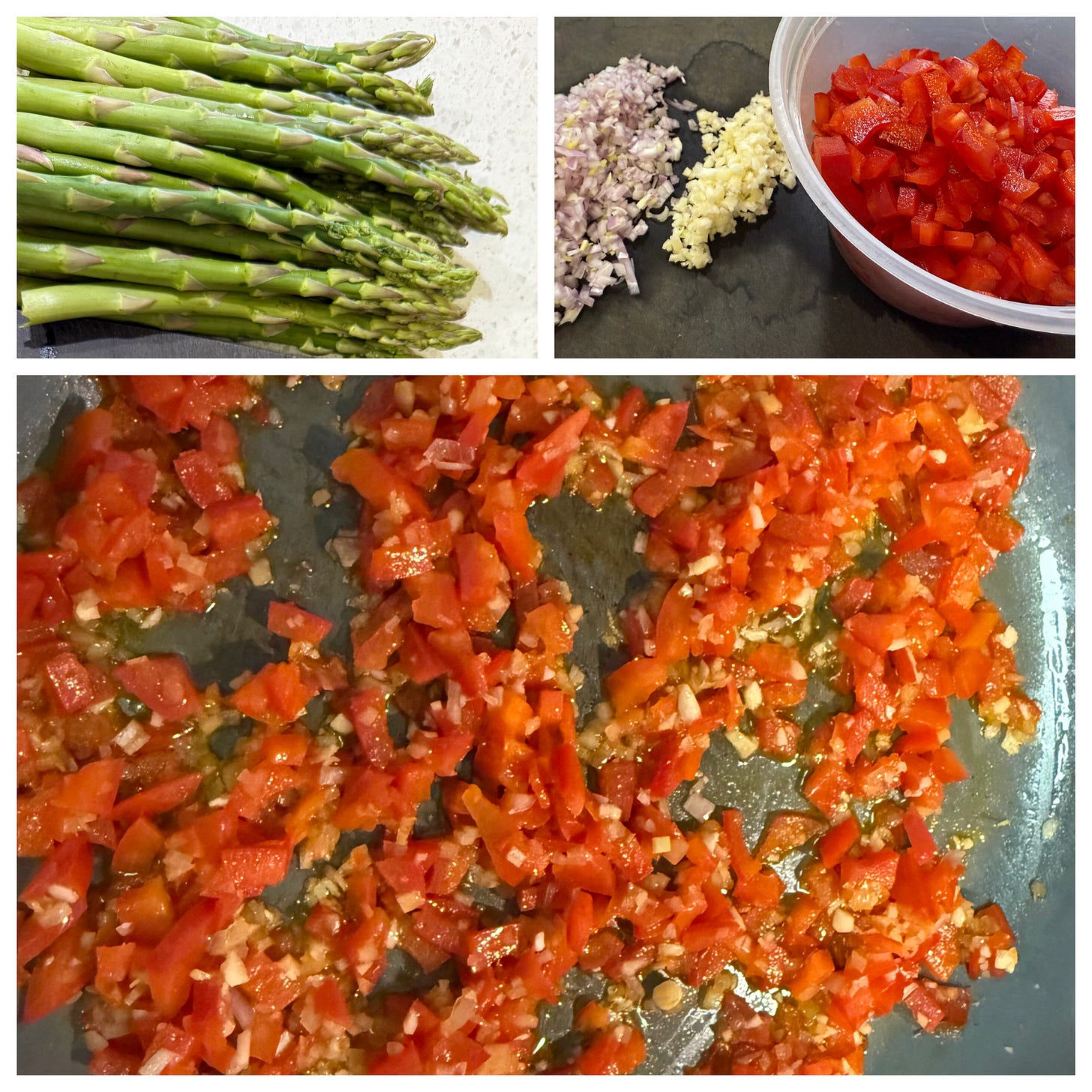Welcome to TASTE | Pacific Northwest's first Accoutrements Flavor Lab. Our mini lab sessions are designed to grow readers’ flavor development skills - while having fun!
Accoutrements are both savory and sweet, so small sauces, creams, vinaigrettes, powders, reductions, chutneys and jams light up every corner of our culinary world with depth of flavor!
What's the best way to celebrate spring? ASPARAGUS!
In a professional kitchen, flavor development is built in layers. Entrees, apps, even soup. Think of luscious flavor as having layers. Our Leek & Winter Vegetable Soup is an easy example:
A bland foundation: a medium-starch potato, like a Gold
Leeks, the second layer: we want to preserve its delicate flavor!
Carrots and parsnips contribute their own unique sweetness so they're the third layer
Herbs, its own layer, of course!
Umami-rich miso, a layer that grounds the soup in a bit of mystery; and
Aromatics - for LIFT!
In the TASTE Flavor Lab, we use the same principle with vegetable accoutrements. Asparagus has an amazing list of flavor affinities, meaning herbs, spices, alliums, aromatics and even other vegetables like fava beans and spring peas that enhance and complement it as the primary flavor.
What are those flavor affinities? A few: basil, bell peppers, capers, cheese, chives, dill, eggs, garlic, ginger, honey, horseradish, leeks, lemon, mustard, nuts, olive oil, olives, orange, parsley, pasta, peas, pepper, pine nuts, polenta, potatoes, rosemary, salt, sauces, sesame, shallots, sorrel, soy sauce, spinach, tarragon, thyme, tomatoes, vinegar and wine.
Simple bright or earthy flavors are best as complements to fresh, vibrant vegetables. Using our layering principle, we developed a simple sauté - Red Pepper-Shallot Relish - to garnish lovely spring vegetables, like asparagus or green beans - over a polenta cake, if you choose!
Layering
Foundational flavor: the asparagus!
Red bell pepper for a distinctive sweetness (and color!)
Shallot and garlic, for warmth and earthiness
Balsamic vinegar, as an aromatic for a bit of complexity
Dijon mustard, depth of flavor and creaminess
Honey, for elevated sweetness, balanced acidity
Red pepper flakes, lightly ground for a tiny bit of heat (optional)
Fresh parsley, for cool green taste and a visual bump!
Kosher salt and freshly grated black pepper - seasoning, always!
Asparagus with Red Pepper-Shallot Relish
Headnotes
Snap asparagus stalks anywhere the stalk is tender, freezing stalk bottoms with other mirepoix (onion cores, carrot trimmings, celery stalks, other veggie trimmings) for vegetable broth or stock.
If you plan to serve the asparagus warm as opposed to at room temperature, cook it off about halfway through preparation of the relish.
Grill, simmer, sauté asparagus stalks until the tip of a knife pierces the stalks with a bit of resistance. Slender or even medium-sized stalks in the spring will only take 2-4 minutes.
Feel free to substitute red wine vinegar for the balsamic if you'd like a sharper tang. We used an aged balsamic simply because we had it on hand. Any good quality balsamic you like will be wonderful. The lightly ground red pepper flakes are optional.
We’ve Upped Our Game!
A note on new elements of value we’re adding going forward.
There are many, many professional techniques and tricks that underlie the best quality recipes. Precision, and a light touch are requisite in professional kitchens.
We’ll be increasing this type of education to help our subscribers raise their skills to further enjoy working with the glorious ingredients that birth the best dishes.
Raising our bar will also include the publication of some of my proprietary recipes - recipes I’ve developed for our restaurant dessert production. Some of those will be behind a paywall.
How will it work?
Free subscribers have access to all the free recipes published during the current calendar year.
All prior year recipes and the complete TASTE | Pacific Northwest newsletter archive are available only to paid subscribers. The 2024 recipe index is coming soon!
Recipe creation, product development and food writing are some of the skills of a professional chef. Substack offers a unique platform to its food community: subscribers have the selective opportunity to pay for what they know has value in their lives.
Creating a library of free content is a service to our readers. Our intent is to imbue each of our reader’s lives with a spirit of inquiry and to infuse it with a bit of joy.
We hope to attract readers who feel our work has value and are willing to pay for that value.
As a writer dedicated to offering what I most love in the world to you, my audience, I fulfill how I choose to work in the world. I choose to bring my professionalism, my dedication to quality, my acquired skills, my creativity, my best advice each day.
Being a chef and food writer is my job.
I don’t write for an algorithm; I've chosen to be part of the Substack community where relationships are built, where authenticity is rewarded, and where community matters.
Being paid for my business, my life’s work, is a step I hope you’ll consider.









